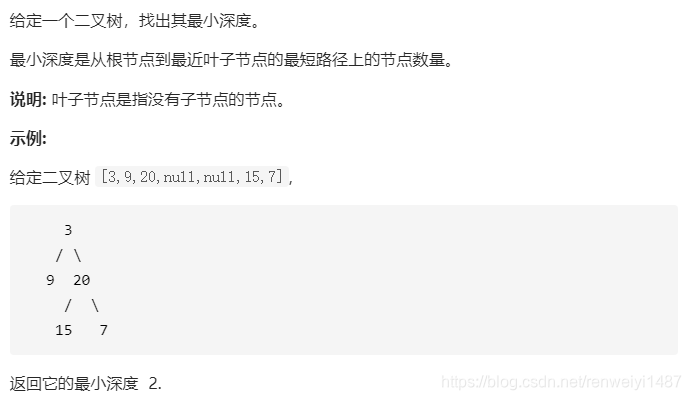
递归
与求二叉树最大深度一样可以使用递归求解,但要注意左子树或右子树为null的情况。
/**
* Definition for a binary tree node.
* public class TreeNode {
* int val;
* TreeNode left;
* TreeNode right;
* TreeNode(int x) { val = x; }
* }
*/
class Solution {
public int minDepth(TreeNode root) {
if(root == null) return 0;
else if(root.left == null) return minDepth(root.right)+1;
else if(root.right == null) return minDepth(root.left)+1;
else{
int leftDepth = minDepth(root.left);
int rightDepth = minDepth(root.right);
return Math.min(leftDepth,rightDepth)+1;
}
}
}
DFS迭代
使用一个队列,首先加入一个根节点,在迭代中每次从头部取出一个结点,并在尾部加入子节点,当取出结点遇到叶子结点时跟新最小深度
/**
* Definition for a binary tree node.
* public class TreeNode {
* int val;
* TreeNode left;
* TreeNode right;
* TreeNode(int x) { val = x; }
* }
*/
class Solution {
public int minDepth(TreeNode root) {
if(root == null) return 0;
if(root.left == null && root.right == null) return 1;
Queue<Pair<TreeNode, Integer>> queue = new LinkedList<>();
queue.add(new Pair(root, 1));//在链表尾部添加结点
int min = Integer.MAX_VALUE;
while(!queue.isEmpty()){
Pair<TreeNode,Integer> current = queue.poll();//取出链表头部元素
root = current.getKey();
int currentDepth = current.getValue();
if(root.left == null && root.right == null)
min = Math.min(min, currentDepth);
if(root.left!=null)
queue.add(new Pair<TreeNode,Integer>(root.left, currentDepth + 1));
if(root.right!=null)
queue.add(new Pair<TreeNode,Integer>(root.right, currentDepth + 1));
}
return min;
}
}
广度优先搜索
深度优先搜索访问了每个节点,广度优先搜索当遇到叶子节点时退出,使用键值对记录每个节点当前的深度
class Solution {
public int minDepth(TreeNode root) {
if(root == null) return 0;
if(root.left == null && root.right == null) return 1;
Queue<Pair<TreeNode, Integer>> queue = new LinkedList<>();
queue.add(new Pair(root, 1));//在链表尾部添加结点
int currentDepth = 0;
while(!queue.isEmpty()){
Pair<TreeNode,Integer> current = queue.poll();//取出链表头部元素
root = current.getKey();
currentDepth = current.getValue();
if(root.left == null && root.right == null)
break;
if(root.left!=null)
queue.add(new Pair<TreeNode,Integer>(root.left, currentDepth + 1));
if(root.right!=null)
queue.add(new Pair<TreeNode,Integer>(root.right, currentDepth + 1));
}
return currentDepth;
}
}
按层遍历
一层一层的遍历,遇到叶子节点则退出,
/**
* Definition for a binary tree node.
* public class TreeNode {
* int val;
* TreeNode left;
* TreeNode right;
* TreeNode(int x) { val = x; }
* }
*/
class Solution {
public int minDepth(TreeNode root) {
if(root == null) return 0;
if(root.left == null && root.right == null) return 1;
Queue<TreeNode> queue = new LinkedList<>();
queue.add(root);//在链表尾部添加结点
int current_depth = 0;
a:while(!queue.isEmpty()){
int size = queue.size();//当前层的结点数
current_depth++;
for(int i = 0; i < size; i++){
root = queue.poll();//取出每一层的每一个结点
if(root.left == null && root.right == null){
break a;//遇到叶子结点则退出
}
if(root.left!=null){
queue.add(root.left);
}
if(root.right!=null){
queue.add(root.right);
}
}
}
return current_depth;
}
}